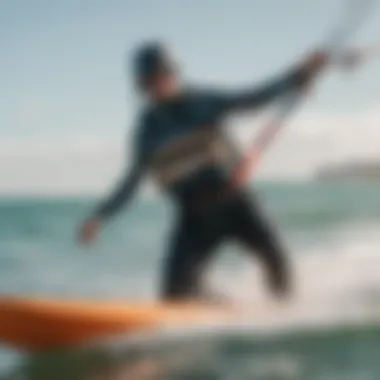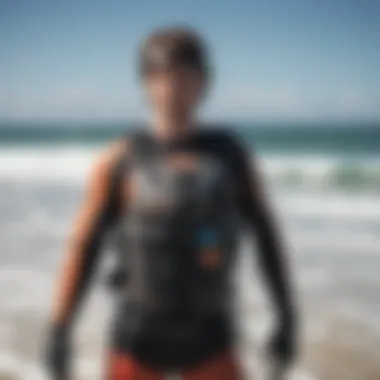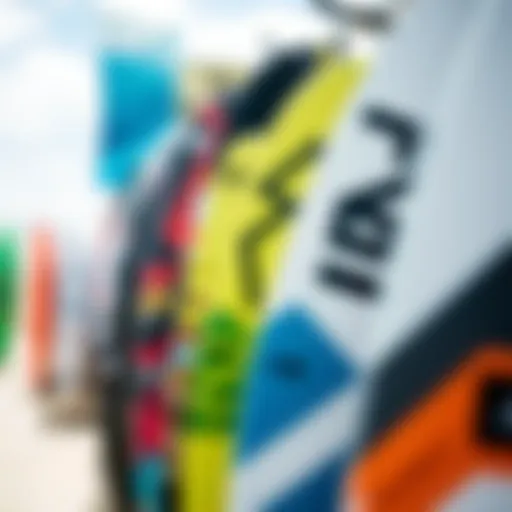Safety First: Your Guide to Kiteboard Life Jackets


Intro
Kiteboarding, while exhilarating, can often tread a thin line between fun and peril. This has everything to do with the essential safety measures that practitioners must take. Among these measures, the importance of life jackets cannot be overstated. They serve not just as compliance gadgets but are vital for survival should misfortune strike. The waves might be inviting, but without proper safety gear, a kiteboarder’s glorious ride can quickly become a nightmare.
Life jackets play a significant role in keeping kiteboarders buoyant and visible. Whether you’re an experienced kiteboarder catching air or a newbie just trying to stay afloat, understanding the nuances of life jackets can enhance one's experience. In this guide, we’ll navigate through the critical aspects of life jackets tailored to kiteboarding, from their features to their integration with other essential gear. Let’s embark on this journey.
Gear Insights
Latest Gear Reviews
When it comes to kiteboarding life jackets, not all are created equal. Recent reviews spotlight various models that combine safety, comfort, and practicality. Here’s a look at some that have made waves among kiteboarding enthusiasts:
- Mystic Marshall Vest
This model blends style with usability. Its lightweight design allows for freedom of movement, which is key during those intense sessions. Plus, the neoprene material ensures warmth in those chillier waters. - Ion Slate Vest
For those who value visibility, the Ion Slate comes in bright colors, making you hard to miss. It also features strategic padding that protects vital areas without sacrificing agility. - Cabrinha Impact Vest
Designed for high-performance riders, the Cabrinha Impact Vest offers impact protection while ensuring comfort. Its snug fit supports active movements on the board, giving you confidence to go for that next big trick.
Each of these models brings something unique to the table, catering to various preferences and styles. Comparing these options can be a fun yet vital part of preparing for a safe ride.
Essential Gear for Beginners
While life jackets are crucial, they are only part of the wider kiteboarding arsenal. If you're just starting out, here’s a checklist of essential gear:
- Kite: Choose a kite appropriate for your weight and wind conditions. A smaller kite is typically easier to handle for beginners.
- Board: Opt for a board that suits your skill level; larger boards give more stability.
- Harness: A good harness redistributes pressure, allowing you to ride longer with less fatigue.
- Safety Leash: Connects to your kite and ensures it doesn’t drift away from you.
Being well-equipped sets the foundation for confidence on the water. As you progress, understanding how life jackets and your other gear interact will become second nature.
"Don’t just suit up; make sure you are suited properly!"
When exploring equipment, remember that investing in quality safety gear is paramount. The right life jacket can make all the difference, whether it’s saving your life or simply ensuring you feel secure as you chase the surf.
Remember, every kiteboarding session should prioritize safety. As one delves into the joys of the sport, staying authentically prepared enhances not just safety but the overall riding experience.
Understanding the Importance of Life Jackets in Kiteboarding
Kiteboarding is as exhilarating as it is risky. Being a blend of wind, waves, and some human ingenuity, this sport connects nature and adventure, but it also demands strict safety practices. A life jacket is more than just an optional add-on; it's a crucial element that can enhance safety and provide peace of mind on the water. Taking time to understand why wearing life jackets is essential can not only save lives but also enhance the overall kiteboarding experience.
Safety First: The Rational Behind Life Jackets
Life jackets serve a straightforward and life-saving purpose – they keep you afloat. In a kiteboarding scenario, where you can find yourself in challenging conditions, having adequate buoyancy is paramount. The chances of falling off your board or getting caught in tricky currents are substantial. A life jacket provides the necessary support to help you stay above water in such situations. Without this support, a minor fall could quickly escalate into a dangerous situation.
Moreover, studies and real-world accounts have shown that people who wear life jackets during water sports are significantly less likely to face severe injuries or fatalities. It’s a statistical reality. Many enthusiasts, in pursuit of the next adrenaline rush, often overlook the need for proper equipment. Trust me, the thrill of kiteboarding can be exhilarating, yet it's vital to recognize that the unexpected can, and often does, happen.
Regulatory Requirements for Life Jackets
In many regions, kiteboarding without a life jacket can land you in hot water, quite literally. Regulatory bodies have implemented strict mandates regarding personal flotation devices (PFDs). Depending on where you kiteboard, these regulations may stipulate specific buoyancy ratings and design standards for life jackets. This ensures that the safety equipment is reliable and capable of performing under varying conditions.
Before heading out, make sure to familiarize yourself with local law requirements. If you're kiteboarding in a hotspot like the Outer Banks in North Carolina, or along kite-friendly beaches in Tarifa, Spain, you must adhere to these rules. Ignoring them can result in fines,warnings, or worse, insurance issues if something goes wrong. Being well-informed will not only keep you compliant but also contribute to a safer environment for everyone involved, especially in busy kiteboarding spots.
Peace of Mind: Riding with Confidence
Not the least of the benefits of wearing a life jacket is the peace of mind it affords. When you're out on the water, confidence can make a world of difference in how you approach your ride. For many riders, the thought of falling or getting swept away can be enough to keep them from pushing their limits.
A comfortable and reliable life vest acts as a psychological boost. You can focus on your kite skills and enjoying the ride instead of worrying about what happens if things go south. There's a certain comfort in knowing that should you find yourself submerged unexpectedly, you have the necessary equipment to assist you back to the surface.
In essence, life jackets are not just floatation devices; they are instruments of safety that allow kiteboarders to harness the power of wind without losing sight of the fundamental rules of safety on the water.
"A life jacket is not just a piece of gear; it's a lifeline."
Types of Life Jackets for Kiteboarding
When you hit the water with your kiteboard, the life jacket you choose can be the thin line between a safe day on the waves and a potential misadventure. It's not just about staying afloat; it's also about comfort, performance, and fitting in with your gear. The types of life jackets available can have distinct characteristics and benefits, catering to various preferences among kiteboarders. Whether you're a pro carving through waves or a novice just dipping your toes in, knowing your options will empower you to make the best choice.
Comparing Different Styles of Life Jackets
Vest style
Vest styles are probably the most recognizable type of life jacket. They typically feature a streamlined design that combines comfort and flexibility, making them quite popular. One key characteristic of vest styles is their ability to allow for a full range of motion. When you're kiteboarding, every twist and turn counts, and feeling restricted can throw off your game.
The unique feature of these jackets is their snug fit, which helps prevent them from riding up while you’re on the water. This means you can focus more on enjoying your time rather than constantly adjusting how your gear feels.


However, on the flip side, some kiteboarders find them less buoyant compared to other options, potentially leading to unease in rougher waters. Overall, if you're looking for something that gives you freedom of movement without sacrificing too much buoyancy, vest style may just be your cup of tea.
Impact vests
Jumping into the realm of impact vests, these jackets are not just your typical life savers; they also provide a layer of protection against hard falls or collisions. One of their main attributes is that they offer an extra level of cushioning for the wearer, absorbing some of the shocks that come with crashing into the water at speed. This characteristic makes them a favored choice for high-energy riding styles.
An advantage of impact vests is their lightweight design, which doesn’t bog you down like some bulkier options might. But, with that lightweight nature, it’s essential to understand that their buoyancy may not be as high as standard life jackets. They offer protection where it counts but might not keep you afloat as effectively in an emergency.
Inflatable PFDs
Inflatable Personal Flotation Devices (PFDs) have become a go-to for many kiteboarders due to their compact nature. When deflated, they take little space, making them ideal for travelers and those looking to minimize their gear weight. The beauty of inflatable PFDs lies in their key feature: they offer substantial buoyancy once activated, ensuring you’ll float when it matters most.
However, it’s worth mentioning that these jackets often require regular maintenance to ensure that the inflation mechanism works flawlessly. If you’re the type who might forget to check your equipment before heading out, this might give you pause. On the other hand, for those who are meticulous, inflatable PFDs can provide optimal safety along with comfort without the bulk of traditional jackets.
Choosing the Right Type for Individual Needs
Selecting the right life jacket is a personal choice that hinges on your specific needs and how you ride. Think about the conditions you usually encounter: rough waters might warrant something with more buoyancy, whereas flat-water riders might prioritize flexibility and comfort. Evaluate if you prefer a jacket that hugs your body or one that solely focuses on protection. The market's diversity means there's likely a design tailored for your preferences.
Seek recommendations from fellow kiteboarders and share stories about what worked and what didn’t. Whether you lean towards a vest-style for freedom, an impact vest for protection, or an inflatable for space-saving convenience, knowing your own riding style and safety requirements is what can lead you to the perfect match.
Key Features to Look For in Kiteboard Life Jackets
When it comes to kiteboarding, a life jacket is not just a recommendation but a must-have item. Underestimating its significance can have serious implications. Selecting the right life jacket involves understanding its key features, which can significantly enhance your safety and overall riding experience. Let’s break down these features to help you make an informed choice.
Buoyancy and Flotation Ratings
Buoyancy is a crucial factor in any life jacket designed for kiteboarding. The effectiveness of a life jacket is measured by its flotation rating, commonly expressed in Newtons or pounds. A higher rating means better support in water. For kiteboarders, especially when conditions are rough, a buoyant jacket can be a lifesaver.
- Why It Matters: In open water or during unexpected tumbles, enough buoyancy ensures that you're kept afloat without much effort. This becomes particularly vital if you’re injured or caught in strong currents.
- What to Look For: Check the flotation rating before purchasing. A flotation rating between 50N to 100N is generally recommended for water sports enthusiasts.
"Safety isn’t expensive, it’s priceless." - Emphasizing that investing in a good life jacket is notable.
Fit and Comfort Considerations
Wearing an uncomfortable life jacket might make you consider leaving it behind, and that’s the last thing you want when you’re hitting the waves. A snug yet comfortable fit is essential for ensuring that the jacket stays in place during rides and doesn’t hinder your movements.
- Adjustability: Look for jackets with adjustable straps. This helps in achieving the right fit, catering to different body types.
- Material Flexibility: Jackets made from stretchy materials offer more mobility, allowing for better dynamics in maneuvering while kiteboarding. You want something that accommodates your movements rather than restricts them.
Durability and Material Choices
Given the environments kiteboarders face—from saltwater to sun exposure—durability is a non-negotiable feature. Life jackets should withstand these harsh conditions without deteriorating quickly.
- Material: Look for jackets made from high-quality, UV-resistant materials. Neoprene and nylon are common choices that resist wear and tear.
- Stitching and Construction: Always pay attention to the stitching quality. Craftsmanship can determine how long your jacket lasts. Double-stitched seams and reinforced areas are signs of a durable product.
By considering these features when selecting a life jacket, kiteboarders can ensure a safer and more enjoyable experience out in the water. It's not just about compliance with safety regulations; it's about enjoying your ride without the nagging worry of equipment failure.
Integrating Life Jackets with Kiteboarding Gear
Integrating life jackets with kiteboarding gear is not just a matter of throwing on a vest and hitting the waves. It's about creating a seamless and effective safety system that enhances your overall experience on the water. Kiteboarding is exhilarating but comes with its fair share of risks; thus, ensuring that your life jacket works effectively with your other gear can make all the difference in a tricky situation.
When it comes to safety, having compatible and well-integrated equipment means that you can ride with confidence. A life jacket that fits nicely with your harness, for instance, allows for greater freedom of movement, which is essential when performing tricks or navigating waves. Similarly, proper adjustability and customization options in your life jacket ensure that it fits snugly, staying in place even during dynamic riding.
Here are key considerations to keep in mind when thinking about integrating life jackets into your kiteboarding setup:
- Comfort: A life jacket that fits well with other gear not only enhances safety but also ensures comfort throughout your kitesurfing session.
- Mobility: You need to maintain the ability to maneuver easily. That's where compatibility plays a crucial role.
- Functional Design: Look for vests designed with kiteboarding in mind. This means streamlined shapes and added functionalities tailored to the sport.
The intersection of safety equipment and kiteboarding gear can be a real game-changer. Let’s delve deeper into specific aspects of integration that every kiteboarder should consider.
Compatibility with Harnesses
The compatibility of your life jacket with your harness holds significant importance in the kiteboarding experience. If your life jacket does not align well with your harness, it can lead to discomfort or, worse, potential accidents while riding.
Harness designs vary, and so do life jackets. For example, a vest that bulks up around the waist might not be suitable for someone using a seat harness. This lack of compatibility can restrict movement or push the harness into your body at awkward angles. To avoid these discomforts:
- Look for life jackets designed specifically for kiteboarding: These often have lower profiles or are cut away in ways that complement common harness designs.
- Check the fit of both the jacket and the harness together: Trying them on together before making a purchase ensures a good match.
Many manufacturers now offer life jackets that take harness styles into account, which is a small but vital detail that can greatly enhance your ride.


Adjustability and Customization Options
Adaptability is a vital feature that kiteboarders should prioritize when choosing a life jacket. The ability to adjust the fit of your life vest allows you to customize the level of snugness, significantly impacting your comfort and safety on the water.
A life jacket with multiple adjustment options—such as side straps, shoulder adjustments, and waist belts—can provide a tailored fit to different body shapes and sizes. This level of customization ensures that your life jacket remains securely in place while allowing you full range of motion for a variety of maneuvers.
Here are some features to look for when considering adjustability:
- Elastic straps: They should allow for quick adjustments without compromising safety.
- Zippers and buckles: Ensure they are easy to operate, even with wet hands.
- Cut and design: Jackets with a more contoured cut can offer both a tighter fit and greater freedom of movement.
In summary, integrating life jackets with kiteboarding gear is critical to ensuring a safe, enjoyable experience. Compatibility with harnesses and the available customization options can lead to a substantial improvement in how you perform on the water. Safety doesn't just come from wearing a life jacket; it's about how well it works with your kiteboarding equipment.
Maintenance and Care for Kiteboarding Life Jackets
In the realm of kiteboarding, life jackets are more than just a regulatory requirement; they are essential for ensuring safety while you’re zipping across waves. But just as a rocket needs fuel, a life jacket requires proper maintenance and care to perform optimally. Keeping your gear in tip-top shape not only enhances its lifespan but significantly contributes to your safety on the water.
Inspection Guidelines for Longevity
Before you hit the waves, it’s crucial to give your life jacket a thorough once-over. Here are some key components to check:
- Visual Inspection: Look for any visible damage. Are there frayed straps or ripped seams? Anything that looks out of the ordinary could spell trouble when you need it most.
- Buoyancy Assessment: Ensure that it’s still buoyant. Most jackets are designed with foam or air chambers for flotation. You can test this by gently pushing it underwater and seeing how well it bobs back to the surface. If it doesn’t, it’s time to consider a replacement.
- Closures and Fasteners: Check all buckles and zippers. These moving parts must function without a hitch. A malfunctioning buckle could make all the difference in an emergency.
- Storage Considerations: After each session, make sure you store the jacket in a dry, cool place. Sunlight and moisture can degrade materials over time.
Regular inspections every few uses will help catch potential issues before you’re out on the water, providing peace of mind.
"A stitch in time saves nine." Taking care of your gear regularly can prevent major issues later.
Proper Cleaning Techniques
The road to longevity often begins with cleanliness. Kiteboarding can get messy; saltwater, sand, and sun all take a toll on your life jacket. Here’s how to clean effectively:
- Rinse Immediately: After each session, make it a habit to rinse off your life jacket with fresh water. This simple step goes a long way in removing salt and sand that can wear down materials.
- Soak and Scrub: Occasionally, soak your jacket in a mixture of warm water and mild soap. Gently scrub with a soft brush or cloth to dislodge any stubborn grime. Avoid harsh detergents, as they can damage the fabric.
- Air Dry: Never toss your jacket in the dryer or leave it in the direct sun for long periods. Instead, hang it to dry in a shady spot, allowing air to circulate without risking damage from heat.
- Inspect Again: Once clean and dry, do another check for any damage. You’d be surprised how a good wash can reveal hidden flaws.
Cleaning and maintaining your life jacket not only keeps it looking sharp but also ensures it retains the necessary functionality when you call upon it. Keeping your gear in good working order is just as vital as picking the right one in the first place.
Popular Kiteboard Life Jacket Models Reviewed
When it comes to kiteboarding, selecting the right life jacket plays a crucial role in not just your safety but also your overall experience on the water. The variety in the design and features of life jackets makes it essential to evaluate them closely to find what best suits your needs. In this section, we will delve into some popular kiteboard life jackets, highlighting their specific elements, benefits, and considerations for potential buyers.
Analyzing Top Performing Life Jackets
Several models dominate the market when it comes to kiteboard life jackets. Here are a few that consistently draw positive attention:
- Liquid Force 2019 Foil Jacket
This jacket stands out for its lightweight design and great buoyancy. Made from flexible materials, it allows for a full range of motion while still providing ample support. The padding in all the right places ensures that it not only keeps you afloat but also shields you from impact. - Mystic Marshall Impact Vest
Renowned for its comfort and adjustment features, this vest fits snugly yet allows for enough freedom of movement. The use of neoprene gives it a soft feel, while the strategically placed foam will protect in case of falls. - ION Radar Vest
With its sleek design, the ION Radar Vest is a favorite among many. Its quick-drying fabric and streamlined fit make it ideal for extended sessions. What’s more, it comes with integrated harness hooks that make it super compatible with your kiteboarding gear. - O’Neill Superlite USCG Life Vest
A solid choice for those who place a premium on safety, this vest is certified by the U.S. Coast Guard, which verifies its safety standards. Plus, it’s designed to allow for good airflow, keeping you comfortable in warmer weather.
Ultimately, when looking for the right life jacket, it’s essential to consider factors such as fit, comfort, and intended use. Every kiteboarder has different needs, so finding a life jacket that ticks the right boxes can positively impact your riding experience.
User Reviews and Feedback
Feedback from fellow kiteboarders is invaluable when making a choice about life jackets. Here’s a summary of insights gathered from user reviews across different platforms:
- Comfort and Fit: Many users emphasize the importance of comfort. A lot of kiteboarders recommend trying the jacket on before purchase to ensure a snug but not restrictive fit. Users of the Liquid Force 2019 Foil Jacket often rave about its lightweight feel and ease of movement, which is crucial for recreational riders and competitive users alike.
- Performance in Water: Performance is a common theme in user feedback. The Mystic Marshall Impact Vest has received praise for its buoyancy and ability to support riders during unexpected tumbles. Several individuals noted how they felt secure while attempting tricks or handling rough waters.
- Durability Concerns: While most reviews highlight positive experiences, it’s also worth noting some concerns. For instance, while the ION Radar Vest is praised for its design, some users have experienced wear after multiple sessions. Regular care and maintaining equipment can prolong the life of these jackets.
"Finding the right life jacket was as crucial as picking my kite! It makes all the difference to have something that allows you to focus on the ride rather than worry about safety." - A satisfied kiteboarding enthusiast.
In summary, user experiences can guide one towards making an educated decision. They provide insights not just into the products’ claims but how they perform in real-world scenarios, adding depth to your understanding of what life jackets can offer.
User Experiences and Safety Stories
In the world of kiteboarding, safety isn’t just a protocol; it’s a necessity that can determine between a great day on the water and a life-altering incident. The role of user experiences and safety stories cannot be overstated in this sport. They serve as cautionary tales, golden nuggets of wisdom, and builders of community norms. Understanding these real-life events can help kiteboarders grasp the gravity of safety gear, particularly life jackets, in their adventures.
Real-Life Accounts of Safety Necessities
Hearing about others' experiences often resonates on a deeper level. For instance, a seasoned kiteboarder named Jake once found himself in a precarious position during a stormy afternoon.
"I always thought I could swim away from trouble until I found myself tangled in my lines in choppy waters," Jake recounted. "I had my life jacket on, and it kept me afloat while I managed to get free. Without it, I wouldn't be telling this story." This experience not only highlights the life-saving benefits of wearing a life jacket but also emphasizes that preparation is a rider's best bet.
Key Takeaways from User Accounts:


- Always Be Prepared: Real stories show that accidents can happen when you least expect them. Wearing a life jacket can give you the edge when things go sideways.
- Trust the Gear: Especially for beginners, there's a lot of learning, and trusting your safety equipment is crucial.
- Share Experiences: Discussing incidents within the community can promote awareness and better practices among fellow riders.
"Safety isn't just about gear; it's about understanding the risks and preparing for the unexpected." — Anonymous Kiteboarder
Community Insights on Life Jacket Use
Communities often form a backbone for sports like kiteboarding. Local kiteboarding schools or clubs frequently share insights that can illuminate the importance of life jackets.
A frequent participant at a popular kiteboarding site in the Caribbean shared, "We have a saying here: ‘Better safe than sorry.’ Our club mandates all members wear approved life jackets during lessons and competitions. It’s about creating a culture of safety."
Such communal norms often drive the behavior of individuals. When everyone around you prioritizes safety, it prompts a deeper understanding among everyone about the necessity to equip oneself properly. The story of Maria, a recreational kiteboarder who trained with a local club, also underlines this concept.
"The first time I went out after getting my jacket, I felt invincible. Knowing that my friends were also wearing theirs made me realize we are in this together. All it takes is one strong gust or sloppy landing for things to go awry," she explains.
Insights from the Community:
- Collective Safety Culture: The adherence to safety gear creates a ripple effect. When you see your peers donning life jackets, it influences others to do the same.
- Education & Training: Conversations about proper life jacket use and safety measures become essential through community interactions, leading to informed riders.
- Promoting Best Practices: Community forums and workshops can act as spaces for exchanging knowledge about new products and technologies in life jackets, keeping everyone updated.
The real experiences of kiteboarders paint a vivid picture of why life jackets are indispensable. These testimonies, shaped by narratives and community insights, reinforce the fundamental belief that even in a thrilling sport, safety should reign supreme.
Kiteboard Life Jackets and Environmental Considerations
As kiteboarding gains popularity, the environmental impact of gear like life jackets becomes a pressing concern. This section focuses on how the design and manufacturing of kiteboard life jackets intersect with eco-friendly practices. From materials to production processes, understanding these aspects not only highlights the importance of sustainability but also helps kiteboarders make informed choices that align with their values.
Eco-Friendly Materials in Design
The materials that comprise a kiteboard life jacket play a pivotal role in its environmental footprint. Traditional life jackets often use chemical-rich foam and synthetic fabrics, which can take centuries to decompose. However, there has been a noticeable shift towards more sustainable materials. Manufacturers are increasingly opting for organic cotton, recycled polyester, and other biodegradable materials when designing life jackets. By doing this, they reduce harmful waste and promote a cleaner environment.
Some brands showcase their commitment by using materials that are sourced responsibly. For example, life jackets crafted from recycled ocean plastics significantly lower the amount of waste in our waters. These efforts not only result in high-quality products but also serve to educate consumers about the importance of recycling and waste management in our oceans.
Incorporating eco-friendly materials brings several advantages:
- Reduced Carbon Footprint: Recycled materials lessen the demand for new resources, ultimately reducing carbon emissions.
- Durability: Sustainable fabrics often boast similar or superior durability compared to their traditional counterparts, meaning a life jacket can be both eco-friendly and resilient.
- Market Demand: Increasingly, customers are voting with their wallets, choosing brands that prioritize the environment, effectively driving the market to adopt greener practices.
Sustainability in Manufacturing Practices
The sustainability of kiteboard life jackets extends far beyond the materials used. The practices behind their manufacturing also bear considerable weight. Many producers are adopting eco-conscious measures such as energy-efficient processes and ethical labor standards. This not only improves the quality of life for workers but also minimizes the impact on local environments.
For instance, some factories focus on minimizing chemical use and waste production during the manufacturing process. By employing low-impact dyes and non-toxic adhesives, they are paving the way for healthier production cycles. Others are investing in renewable energy sources, which further curbs greenhouse gas emissions.
Moreover, sustainability in manufacturing often aligns with local economic growth. Manufacturers who commit to eco-friendly practices may source materials locally, supporting communities and reducing transportation emissions.
In adding to this, certain manufacturers even offer take-back programs, where used life jackets can be returned for recycling or proper disposal. This ensures that no product is left to clog our landfills or oceans. Users can feel a sense of duty knowing their choice in gear keeps sustainability in mind.
"In a world where every choice counts, embracing environmentally responsible kiteboarding gear makes every ride much more rewarding."
As kiteboarding continues to evolve, the integration of eco-friendly materials and sustainable practices in life jacket production isn't just a trend—it's a necessity. Making informed decisions about gear not only benefits the user but also contributes positively to the planet, leading the way for future generations of kiteboarders.
The Future of Kiteboard Life Jackets
As we look towards the future of kiteboarding, the role of life jackets is evolving substantially. This evolution isn't just about compliance; it’s about enhancing the kiteboarding experience itself. The advent of new technologies, changing user habits, and increased environmental awareness are transforming life jackets into smarter, safer, and more efficient devices. For kiteboarders, instructors, and adventure seekers, understanding these trends isn't just beneficial; it's essential.
Innovative Technologies on the Horizon
In recent years, the kiteboarding safety gear landscape has begun to see developments reminiscent of trends in other sports equipment. One such advancement is the integration of wearables and smart technology into life jackets. Imagine a life jacket equipped with sensors that monitor your heart rate or location—providing alerts in case of emergencies. These innovations can significantly increase safety margins while riding.
Alongside this, we could also observe shifts towards lighter and more comfortable materials. Think of ultra-lightweight fabrics that don’t just offer buoyancy but also allow for greater freedom of movement. For kiteboarders whizzing through the waves, comfort can be as crucial as safety. One notable example might be the advancement of hydrophobic materials that keep jackets drier and prevent waterlogging, leading to better buoyancy performance.
Moreover, designs are expected to incorporate modular features. This means kiteboarders might be able to attach or detach specific components based on their riding needs. For instance, an inflatable bladder that can be deployed in an emergency could be standard equipment on future jackets.
Predicted Trends in Safety Gear
The shifting landscape of kiteboarding safety gear reflects broader trends in both technology and environmental responsibility. As kiteboarding grows in popularity, we see a shift towards increased regulations; manufacturers are likely to respond to this by developing life jackets that not only meet but exceed these standards. Enhanced safety certifications could become the norm, with brands competing to showcase their achievements.
Furthermore, sustainability will likely be a driving force in future developments. Many brands are beginning to explore environmentally friendly materials in their designs. Kiteboarders are progressively more aware of their environmental impact, which means the demand for eco-conscious products will increase. Brands might dive into using recycled materials or biodegradable components, aligning with a broader push toward responsible manufacturing practices.
"In the future, every kiteboarder may ride with a life jacket that not only ensures their safety but also supports the health of our planet."
Also, there's an increasing trend towards customization. Kiteboarders want gear that reflects their unique style and preferences. As a response, manufacturers may offer ways to personalize colors, patterns, or even features like pockets and pouches. This trend not only enhances aesthetics but can also lend practicality, making it easier for riders to store essential gear unobtrusively.
In summary, the future of kiteboard life jackets is not just about safety. It's about merging functionality with comfort and environmental care. Embracing these advancements can ensure riders feel secure while riding, while also safeguarding the ecosystems they enjoy.
With the kiteboarding community continually pushing boundaries, it’s vital for riders to stay informed and adapt to these changes. The rise of innovative technologies and trends in safety gear will surely redefine what it means to ride safe, embracing both the thrill of the sport and the responsibility of preserving our environment.















